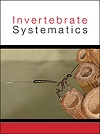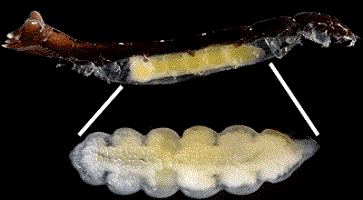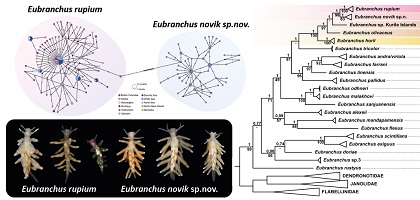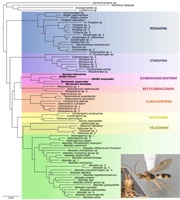The parasitic isopod family Cabiropidae is known to utilise various isopods but lacks records of members parasitising Anthuroidea. We describe Anthuroniscus gen. nov. for three new cabiropid species, Anthuroniscus shimomurai sp. nov., Anthuroniscus dentatus sp. nov. and Anthuroniscus latus sp. nov., all of which are parasitic on anthuroid isopods. This is the first study reporting Cabiropidae from Japan and anthuroids as hosts for not only Cabiropidae but also Cryptoniscoidea. (Image credit: Shoki Shiraki.)

Invertebrate Systematics
Volume 38 Number 8 2024
Species of the genus Eubranchus Forbes, 1838 are common in boreal benthic ecosystems. Recent studies suggest the trans-Arctic Eubranchus rupium (Møller, 1842) is a species complex. This paper conducts an integrative taxonomic study of Eubranchus rupium and related species, confirming its amphiboreal distribution. The divergence of the species complex is estimated from the late Miocene or the Miocene–Pliocene boundary to the late Pliocene with the north-western Pacific as the probable ancestral region, followed by dispersal and allopatric speciation. (Image credit: Darya Grishina.)
Tribal relationships within the braconid subfamily Rogadinae are reconstructed based on nuclear UCE data and extensive taxon sampling. Our fully supported estimate of phylogeny and the morphological evidence led us to erect a new rogadine tribe, Gondwanocentrini Shimbori & Zaldívar-Riverón trib. nov. Facitorini was also confirmed as a separate rogadine tribe. Our updated classification expands the number of tribes and genera within Rogadinae to 8 and 66 respectively. (Image credit: Eduardo M. Shimbori.)
A new genus of an ant-mimetic plant bug, Carenotus gen. nov. and eight included species are described as new to science. The ant-mimetic or myrmecomorphic traits of Carenotus and other ant-mimetic taxa are documented. This genus is analysed phylogenetically using myrmecomorphic and genitalic characters. Three ant-mimetic genera form a monophyletic group on the basis of myrmecomorphic traits and the Carenotus species relationships are fully resolved on the basis of genitalic characters. (Image credit: Hannah Mathews.)
IS23013 Abstract | IS23013 Full Text | IS23013PDF (33.9 MB) Open Access Article








